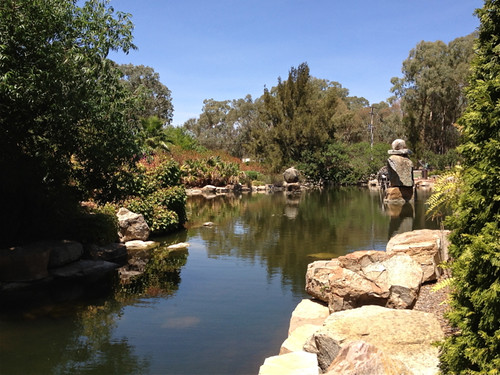I've been thinking about these matters because I visited the south-west NSW town of Young again to help my cousin sort and distribute the possessions of another cousin who died recently. We had some time to spare and decided to follow the sign to the Chinese Tribute Gardens that we'd passed many times on our way to and from our cousin's residence. I'd expected that the Gardens would in some way mark the 'riots' between Chinese and European goldminers in the mid-nineteenth century. Young began its history with the name 'Lambing Flat' and is infamous in modern Australian history for the 1861 conflict between Chinese and European miners who flocked to work the recently discovered gold deposits. There was a history of tension between Chinese and European miners in many goldfields across the 1850s and it is generally agreed that the conflict at Lambing Flat was the most violent and presented the greatest threat of civil unrest. The riot was in fact a number of attacks by European miners on the Chinese in the early part of 1861 that resulted in a police and military presence in Lambing Flat for a large part of 1861 and an uneasy truce with Chinese and European miners in segregated areas of the goldfields.
These events reflected many of the debates and tensions within parliament and the wider society and resulted in the passage in the NSW parliament of the Chinese Immigration Regulation and Restriction Act 1861 - a precursor of the infamous White Australia Policy.
Anyway, back to our visit to the Chinese Tribute Garden:

It was a lovely place to visit on a hot inland day - coincidentally at the time of Chinese New Year. There are some of the required elements of a Chinese garden - plants, water and rocks, though the garden misses the element of a pavilion or contemplative room. There's an arched bridge, a gateway, ducks and swans, and meandering walkways that frame the views. However, there's a spaciousness that I don't remember in any of the Chinese gardens I visited in China, and the bright blue sky and surrounding gum trees are of course very foreign to traditional Chinese gardens. But all in all, it's a real pleasure garden.

What surprised me was the information plaque at the entrance to the garden. No mention of the Lambing Flat riots. The plaque tells the history of the garden site. The small lake around which the garden is based is called 'Chinaman's Dam'. A creek was originally dammed by some European miners to facilitate alluvial mining and was later sold to a group of Chinese miners - hence the dam's name. Even this is a story of loss and dispossession for the Chinese miners. The sale was never formally registered and the land was resumed as Crown Land which it remains until today. The plaque goes on to say (without evident irony) that the garden is a tribute to the contributions over many generations that Chinese Australians have made to our history.
We also had time to visit the Lambing Flat Folk Museum in town and amid all the random elements of small-town historical museums (which in this particular case included my Auntie Mollie's exquisite cream-coloured satin wedding dress from the late 1930s) we found a detailed and dispassionate retelling of the story of the goldfields' conflict and the original roll-up banner under which European miners had marched on the Chinese miners.
I'm really not much further ahead with knowing how to mark such events in our history. But I do know we must continue to tell the stories, and we must realise that some of the vaunted events of our past - such as the Eureka Stockade or the events leading to Federation - were near neighbours and sometimes bedfellows of racist and unjust actions and laws.
3 comments:
I think sometimes in modern society we imagine we are at an endpoint wherein we are collectively chastened having been illuminated by events of the past we now recognize as mistakes (or worse). Your comments remind me it is very much all still a work in progress that is aided by doing just as you say, marking occasions and reflecting upon them.
as soon as i saw your post title i thought 'lambing flat' and i hoped that maybe there was some mention of the riot, because it was so incredibly important at the time and set the tone for so much policy to come. so its disappointing but not surprising to see it not mentioned. i see this a lot with indingeous issues as well, i recently had an argument with someone about how 'we have all created this great country together, including aboriginal people' and i got cranky because 'this nation' rests on past and present dispossession. to me, its part of the great australian silence. we dont want to be responsible for what happened in the past, or link it to anything thats still happening today, so we ignore and pretend everythings great. celebrating positive contributions is great, but its a hollow celebration when it doesnt tell the truth about what was lost. having said that, i am glad to hear there is a Chinese presence in young at all!
In 1967 Arthur Huck wrote a book on The Chinese in Australia. Its emphasis was on numbers. Snippets include:In the 1850s there were more than 38,000 Chinese in Australia (only a handful of women). This number was 3.25% of the total population. In 1861 only 11 Chinese women were counted in Australia.
"Work in Progress" is certainly apposite!! Thank you for the stimulating post.
Post a Comment